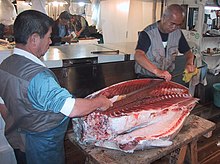| Revision as of 16:36, 4 March 2010 editBueller 007 (talk | contribs)Extended confirmed users19,702 editsmNo edit summary← Previous edit | Revision as of 06:25, 8 March 2010 edit undoSmackBot (talk | contribs)3,734,324 editsm Date maintenance tags and general fixes: build 402:Next edit → | ||
| Line 1: | Line 1: | ||
| {{Refimprove|date=March 2010}} | |||
| {{refimprove}} | |||
| ] at the ]. The knife curves along the line of the spine]] | ] at the ]. The knife curves along the line of the spine]] | ||
| ], including a long oroshi hōchō, used to filet ] at the ]]] | ], including a long oroshi hōchō, used to filet ] at the ]]] | ||
| Line 6: | Line 6: | ||
| {{nihongo||おろし包丁|'''Oroshi hōchō'''|lit. "wholesale knife"}} and {{nihongo||半丁包丁|'''hanchō hōchō'''|lit. "half-tool knife"}} are extremely long, highly specialized ] used in ] to ] ] and other large ]. | {{nihongo||おろし包丁|'''Oroshi hōchō'''|lit. "wholesale knife"}} and {{nihongo||半丁包丁|'''hanchō hōchō'''|lit. "half-tool knife"}} are extremely long, highly specialized ] used in ] to ] ] and other large ]. | ||
| The ''oroshi hōchō'' is a longer knife with a blade length of 150 cm (60 inches) in addition to a 30 cm (12 inch) handle. It can fillet a tuna in a single cut, although usually two to three people are needed to handle the knife and the tuna. The flexible blade is curved to the shape of the spine to minimize the amount of meat remaining on the tuna ]. The hanchō hōchō is the shorter blade with a length of around 100 cm (39 inches) in addition to the handle. The hanchō hōchō is also sometimes called a {{nihongo||マグロ切|maguro-kiri|lit. "tuna-cutter"}}{{ |
The ''oroshi hōchō'' is a longer knife with a blade length of 150 cm (60 inches) in addition to a 30 cm (12 inch) handle. It can fillet a tuna in a single cut, although usually two to three people are needed to handle the knife and the tuna. The flexible blade is curved to the shape of the spine to minimize the amount of meat remaining on the tuna ]. The hanchō hōchō is the shorter blade with a length of around 100 cm (39 inches) in addition to the handle. The hanchō hōchō is also sometimes called a {{nihongo||マグロ切|maguro-kiri|lit. "tuna-cutter"}}{{Citation needed|date=March 2010}}. | ||
| They are commonly found at ] fish markets in Japan, the largest of which is the ] in ]. They may be found at very large restaurants, but they are not used in a regular ], unless there is a frequent need to fillet tuna with a weight of 200 kg (440 pounds) or more. | They are commonly found at ] fish markets in Japan, the largest of which is the ] in ]. They may be found at very large restaurants, but they are not used in a regular ], unless there is a frequent need to fillet tuna with a weight of 200 kg (440 pounds) or more. | ||
| Line 12: | Line 12: | ||
| To those unfamiliar with Japanese knives they may be confused with ]. However, they are not a weapon but a tool, although they have been used as weapons by ].<ref name="Bestor">Bestor, Theodore C. ''Tsukiji: The Fish Market at the Center of the World''. University of California Press, 2004, p. 26.</ref> | To those unfamiliar with Japanese knives they may be confused with ]. However, they are not a weapon but a tool, although they have been used as weapons by ].<ref name="Bestor">Bestor, Theodore C. ''Tsukiji: The Fish Market at the Center of the World''. University of California Press, 2004, p. 26.</ref> | ||
| {{ |
{{See also|Japanese cutlery}} | ||
| ==Notes== | ==Notes== | ||
Revision as of 06:25, 8 March 2010
| This article needs additional citations for verification. Please help improve this article by adding citations to reliable sources. Unsourced material may be challenged and removed. Find sources: "Maguro bōchō" – news · newspapers · books · scholar · JSTOR (March 2010) (Learn how and when to remove this message) |




Oroshi hōchō (おろし包丁, lit. "wholesale knife") and hanchō hōchō (半丁包丁, lit. "half-tool knife") are extremely long, highly specialized knives used in Japan to fillet tuna and other large fish.
The oroshi hōchō is a longer knife with a blade length of 150 cm (60 inches) in addition to a 30 cm (12 inch) handle. It can fillet a tuna in a single cut, although usually two to three people are needed to handle the knife and the tuna. The flexible blade is curved to the shape of the spine to minimize the amount of meat remaining on the tuna chassis. The hanchō hōchō is the shorter blade with a length of around 100 cm (39 inches) in addition to the handle. The hanchō hōchō is also sometimes called a maguro-kiri (マグロ切, lit. "tuna-cutter").
They are commonly found at wholesale fish markets in Japan, the largest of which is the Tsukiji fish market in Tokyo. They may be found at very large restaurants, but they are not used in a regular Japanese kitchen, unless there is a frequent need to fillet tuna with a weight of 200 kg (440 pounds) or more.
To those unfamiliar with Japanese knives they may be confused with Japanese swords. However, they are not a weapon but a tool, although they have been used as weapons by Yakuza.
See also: Japanese cutleryNotes
- Bestor, Theodore C. Tsukiji: The Fish Market at the Center of the World. University of California Press, 2004, p. 26.